Affiliate disclosure: This post may contain affiliate links. Please see our Privacy Policy.
The St. Johns Wort plant is easy to identify in the wild, and it grows just about everywhere along roadsides, in fields and forest edges. With all the press it’s getting for its potential medicinal benefit, learning to identify St. Johns Wort means you can make your own remedies at home.
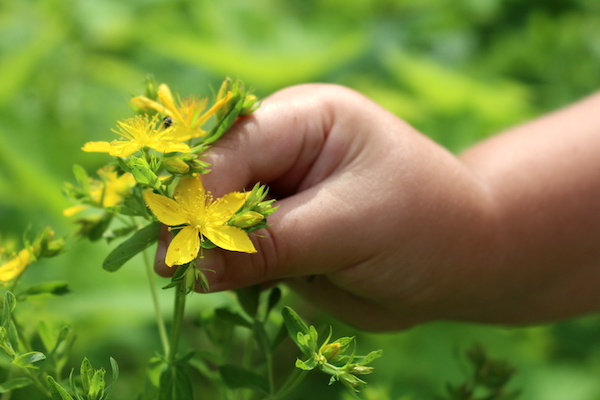
While most herbal remedies can easily be made with dried store-bought herbs, the St. Johns Wort plant is different. The herb is only potent when used or extracted fresh, and dried St. Johns Wort herb is more or less useless. If you want to use the St. Johns Wort plant to make your own remedies, learning to identify this common herb in the wild is essential.
Saint Johns Wort plants are perennial herbs that spread through underground rhizomes as well as seeds. They can grow up to 3 feet high, but they’re often smaller, especially in places along roadsides that see periodic mowing. Once you’ve spotted a patch of Saint Johns Wort plants, mark the place in your mind because they’ll return in the spot every year.
While it’s most commonly harvested wild, you can also grow St. Johns’ wort in your garden with these St. Johns Wort Seed Packets, so you’ll always have it fresh at hand when you need it.
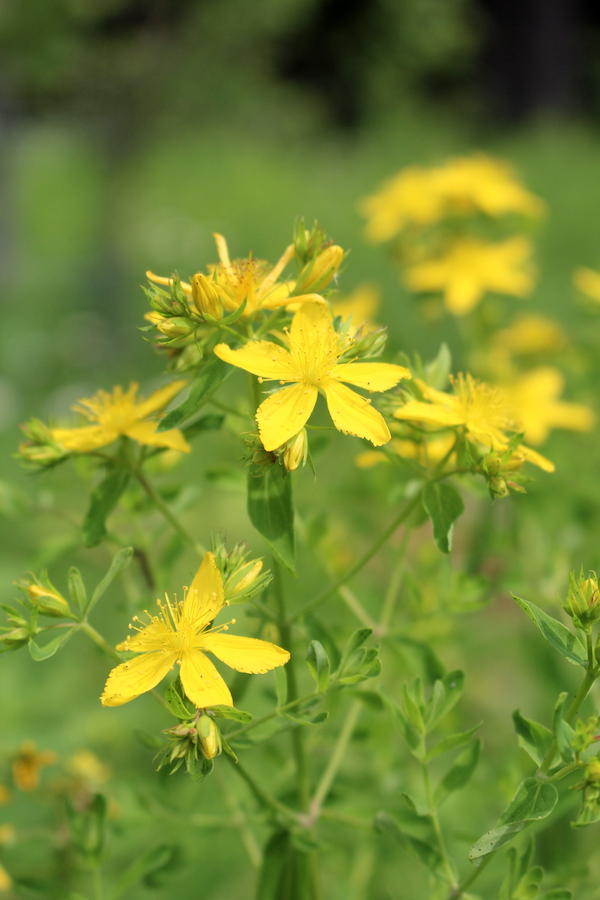
Identifying St. John’s Wort Plants (Hypericum perforatum)
The scientific name, Hypericum perforatum, actually gives a clue that’s really valuable for identifying the St. Johns Wort plant in the wild. The species name “perforatum” refers to the fact that the leaves of the plant are “perforated” or appear to have tiny holes which can only be seen on close inspection.
If you hold one of the tiny leaves up to the light, you’ll be able to see right through numerous translucent zones that look like pin-sized holes. They’re not actually holes, but rather translucent spots on the leaves with glandular tissue. Holding them up to the light actually amplifies the translucent spots, and they’ll almost seem to glow as the light passed through.
I remember when I was first learning to identify St. Johns Wort more than a decade ago, and my herbal mentor handed me one of the leaves, showing me how to hold it up to the sun. It was really beautiful, the way the light glows a bit as it passes through all those unexpected tiny “perforations.”
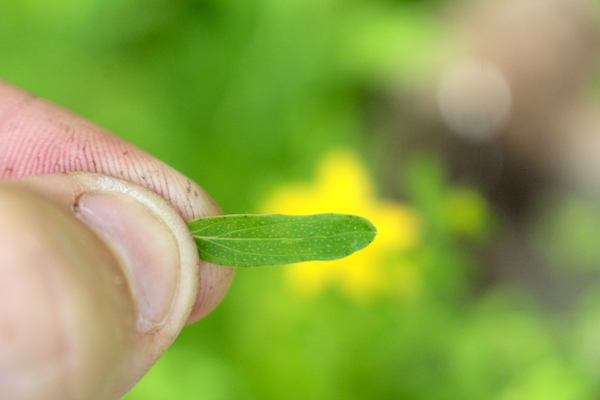
While that’s the best way to positively ID the plant up close, how do you spot Saint John’s Wort plants to inspect? The bright yellow blossoms are what does it for me every time.
The yellow is so vivid, it almost seems to glow in the summer sun. Up here in Vermont, they bloom for the whole month of July during the hottest and sunniest part of the year.
The blossoms catch the light and now that I know what to look for it’s easy. With a keen eye and practice, I can even spot them along the roadside at highway speed as the bright yellow bundles stand out well against the green background.
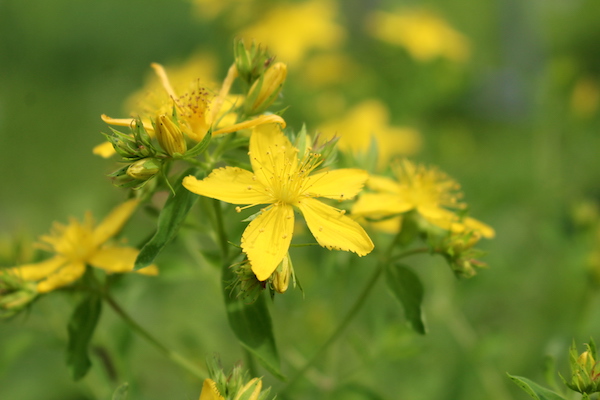
Another good way to identify Saint Johns Wort plants is to crush a flower between two fingers.
Flowers, flower buds and seed pods all exude a reddish-purple liquid when crushed. The flowers themselves only put out a tiny bit and it’s easy to miss but try crushing a flower bud for better results. I’ve found this only works well on dry days, and when the blossoms are covered in morning dew they don’t seem to stain the fingers in the same way.
If you don’t get a red/purple stain from the flower buds, don’t worry. It’s a nice final plant identification step but not completely essential if you’ve already spotted the perforated leaves and 5 petaled yellow flowers.

The individual blossoms vary in size from quite small to around an inch across and have 5 bright yellow petals. The ends of the upper branches fork towards the top, ending in many small flowers per stalk. They’ll open a few at a time over a long season, and when I’m harvesting Saint John’s Wort flowers I try to come back every other day until I have enough for home remedies.
Flowering tops are generally the parts used medicinally, and they’re only viable fresh. When you harvest Saint Johns Wort, the blossoms need to be placed in either oil or alcohol as soon as possible to create an extract.
Alternatively, the flowers can be used fresh when in season for tea. Winter tea made from dried Saint Johns Wort may potentially have a placebo effect, but most herbalists will say you’re wasting your time once the plant material is dried.
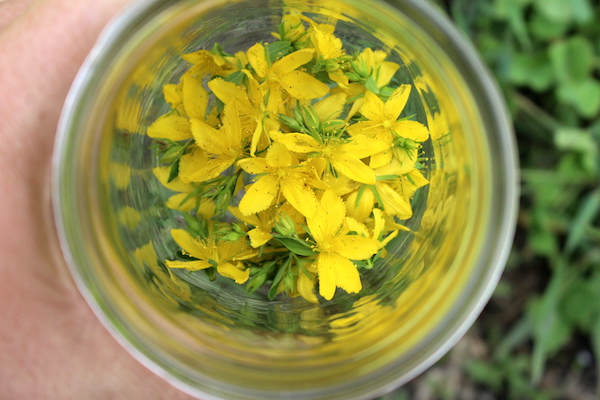
St. Johns Wort Uses
So now that you’ve successfully identified and harvested the Saint Johns Wort Plant, how is it used?
As I mentioned earlier, don’t bother drying the flowering tops. They’re best made into a plant extract in either oil or alcohol on the same day they’re harvested.
Since the plants blossom over a long period, you can add a small amount of oil or alcohol to the jar, just enough to cover the blossoms. Add more the following day and repeat until you have as much as you want or need.
How it’s used depends on how it’s extracted, be it an oil or alcohol extraction. St. Johns Wort oil is generally used topically to speed wound healing, reduce scarring and for its antibiotic properties.
Alcohol or glycerine extractions, on the other hand, are taken internally and are showing promise for their ability to treat mild depression and symptoms related to menopause.
Saint Johns Wort Oil
The St. Johns Wort Plant actually gets its common name from the Order of Saint John, which used it to treat wounds in the crusades. St. Johns Wort oil is currently being studied for its antibiotic properties (source), and historically this was an important use for this common pasture weed.
Other studies show that it can speed wound healing, reduce scarring and minimize pain after surgery. Specifically, one study found that it had a pretty dramatic effect when used 3x per day for 16 days on cesarian section scars post-surgery. Not only did it reduce scarring as compared with placebo, but it also resulted in less pain during the recovery process.
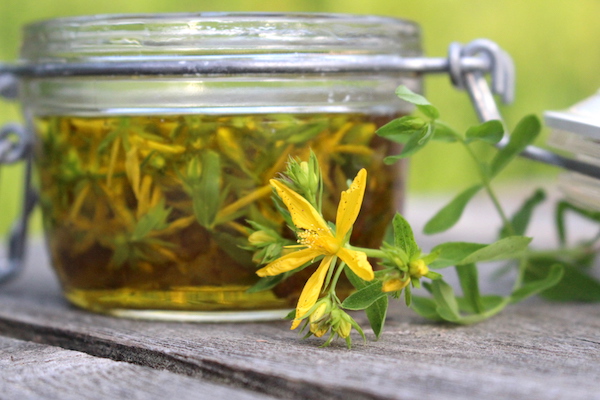
Saint Johns Wort Extract (Tincture)
An alcohol extract is one of the most common ways to preserve Saint Johns Wort for year-round use. To make a St. Johns Wort extract, also known as a herbal tincture, start by filling a jar about 2/3rds full with flowering tops.
Fill the jar with a neutral spirit, such as vodka. No need to use everclear or high proof spirits, and those may actually prevent the extraction of the water-soluble constituents that are extracted alongside the alcohol-soluble ones.
Cap the jar, give it a shake and store out of direct sunlight for about 6 weeks. Shake it every time you think about it, and once it’s fully extracted, filter the plant material and store it in an amber dropper bottle.
Since St. Johns Wort is often taken for depression, many people prefer to make an alcohol-free extract. Vegetable glycerine is a great alternative, and it makes an alcohol-free St. Johns Wort extract that has a hint of sweetness to help the medicine go down. Follow the same procedure, but use food-grade vegetable glycerine in place of alcohol.
St. Johns Wort Side Effects
Personally, I’ve never experienced any side effects with Saint Johns Wort. However, some people have strong adverse reactions to the Saint Johns Wort plant and medicines made from it.
In some countries, St. Johns Wort based medications are only available by prescription, and its use is outright banned in France. In the US, it’s available over the counter as a herbal supplement without much fuss.
Still, the list of potential adverse reactions to common prescription drugs is lengthy. WebMD has a much more exhaustive list, but here’s a few notable St. Johns Wort side effects to be aware of:
- Decreases estrogen levels in the body, and can have interactions with contraceptive pills. That same effect is beneficial in some people and it’s used to treat menopausal symptoms such as hot flashes.
- May impact fertility, causing increased difficulty with conception due to hormonal impacts.
- Can speed the cycling of depression/mania in people with bipolar disorder, bringing on more manic episodes.
- Can worsen the symptoms of ADHD, especially when combined with interaction with common ADHD medications.
- Can interact with anesthesia drugs, and patients should stop taking it at least 2 weeks before surgery.
Contact with the plant can cause photosensitivity, resulting in a high susceptibility for sunburns. Similarly ingesting the plant in herbal remedies causes visual and skin photosensitivity in some (but not all) people.
Though most people can take it without issue, provided they’re not taking a drug that reacts adversely to St. Johns Wort, some people may experience gastrointestinal discomfort, nausea, dizziness, restlessness, and headache after taking the herb.
Disclaimer: I am not a doctor and I don’t play one on the internet. The above is based on my own research and is for education purposes only. It should not be considered an alternative to qualified medical advice or treatment. As always, do your own research and verify everything for yourself before making informed decisions with your doctor.
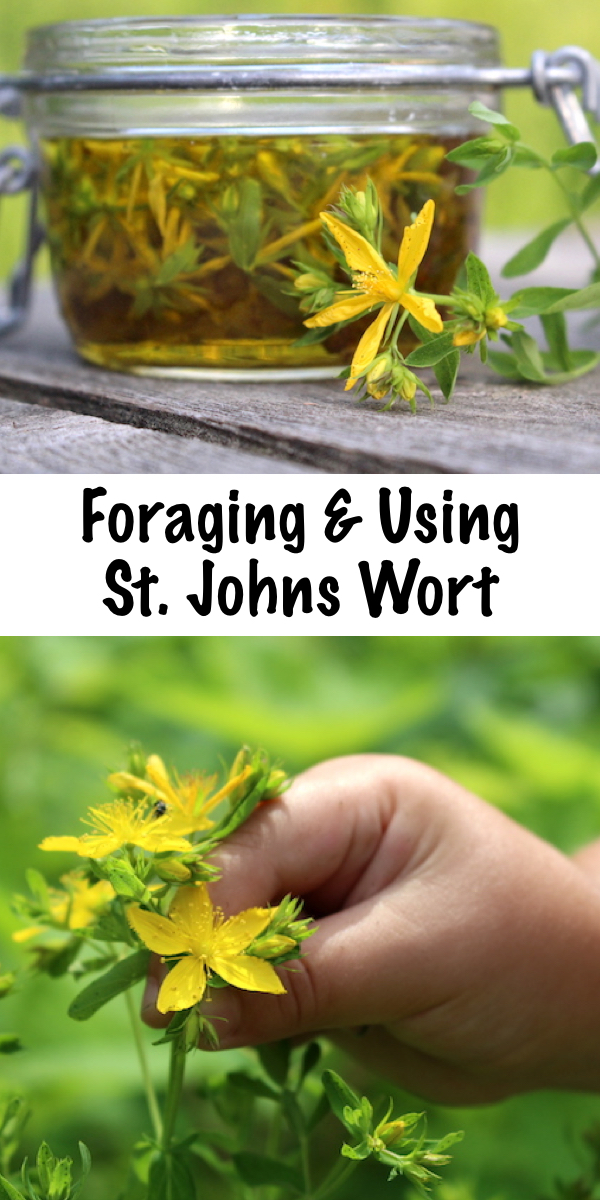














Will vanilla work since it has alcohol?
That’s an interesting idea. I have never heard of anyone doing anything like that before.
Hi! I have been looking for a definitive answer to my question. Maybe you can help? If St john’s wort is only usable when fresh, will the capsules in the supplement isle do anything for you? I assume, no. But then how do they prescribe it in Germany etc? I have a mini apothecary cabinet, and I would like to be more confident in its uses, but I want to be sure I’m using it correctly. I bought a large bag of dried, to make oil, only to read in my findings later it was useless. Why would they even sell it then? thank you for listening, hope you have some insight.
Most all herbalists will tell you that St. John’s Wort needs to be used fresh. There is a chance that you could get some benefits with the dried herb but most of the benefits are degraded by the drying process. I did find an article that stated that freeze drying the herb could possibly preserve the activity of the fresh plant. It’s possible that some manufacturers could be using that process. When you infuse an oil with the fresh herb, you will get a deep red color but when infusing it with the dried herb, the color of the oil remains unchanged.
Another often overlooked point is that when you WASH St Johns Wort or Dandelion etc (especially the flowers) to remove car soot, dog pee and snail slime, it is best done with a few drops of liquid soap in cold (Yes, COLD) water.
If you use warm or hot water, then the “nutritional value” of the flowers etc drops dramatically.
The same principal applies to when you make tea and the hot water causes the tea leaves to release the “tea” from the leaves.
If you use hot or warm water to “wash” your plants, be aware that you will be releasing many of the beneficial nutrients that you will just throw away whilst washing.
WHY SOAP DROPS?
This is to break up the viscosity of the water (water tension) and any insects hiding in the leaves or flowers do not have “air pockets” to breathe since the soap dissapates these air bubbles.
I personally do not usually wash any plants that I collect. I usually collect them in places that I know are clean. As far as the bugs, I think I would rather risk a few bugs than to use soap on them. I am sure it’s a personal preference though.
I live in Northern Ohio. I have four (4) St.John’s Wort Hypericum Calycinum (2 year old plants) that have never bloomed. One plant had one bloom last year. When I lived in Maryland. I had several st. John’s Wort plants that bloomed from summer to Fall. What am I doing or not doing correctly?
You want to be sure that it is getting lots of sun and yearly pruning and deadheading spent blossoms will help promote blooming.
Awesome post
I have a 4 year old St John’s Plant/Bush in my yard and only garden organically. I bought it at a beautiful local market from a natural grower. Can I harvest those flowers or is this landscaping variety not medicinal?
thank you
Joyce
That is a good question, and one I honestly don’t have the answer to. There are some varieties selected for more potent medicinal properties, so it’s possible that the one you have is better than the average wild one…but it’s also possible that it’s less potent. Who knows.
To the best of my knowledge, there is no “landscape” variety that’s completely non-medicinal, so I would guess it’d still have the same properties…but I honestly don’t know for sure.
Among herbalists it’s considered that only Hypericum perforatum, the plant pictured in this post, is medicinal. But I have also heard that other native species can be medicinal. I would not be very inclined to use an ornamental Hypericum species for medicine.
Hi, one of the most important things to note with taking St. John’s wort internally is that it interacts with the liver and can interfere with a number of medications. ALWAYS check for drug-herb interactions if you are on any type of prescription drugs. This is especially important for people who are HIV positive or on anti-depressants.
My other experience with St. John’s wort is that whether it works for depression really depends on the person and their level of depression.
What a great idea to forage for St. John’s Wort. It seems like this may be a beneficial herb to grow on your property too depending on how easy it is to grow. We are definitely going to check it out because it seems there are many benefits and healing properties to St Johns Wort. Thanks so much for sharing!